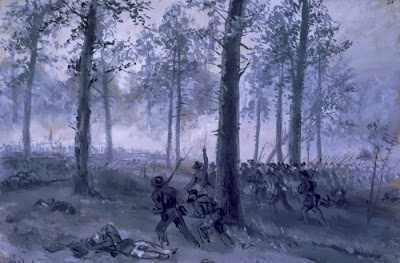STREET (relation to author)
George M.D. Street (1845-1923) - 2x great grandfather,
James Joseph Street (1824-1916) - 3x great grandfather,
John Waller Street (1826-1909) - 3x great grand uncle
Confederate troops advancing through the woods. (Library of Congress)
The battle is over. It was 150 years ago from this past week that the Confederate troops engaged the Federal forces along the Chickamauga creek in northern Georgia. Although in the end, the Confederates had forced back the Union troops into retreat, the three day long confused and exhausting conflict would be considered a tactical defeat for the South when General Braxton Bragg failed to pursue the defeated forces back to Missionary Ridge and then Chattanooga.
In the midst of the Confederate forces, three men from Tippah County Mississippi fought together through the frightening and exhausting troop movements and violent conflicts of those three days of September 18-20, 1863.
Link to animated map provided by the Civil War Trust.
In April of 1862, James Joseph Street and his eldest son, George M. D. Street, and James' younger brother, John Waller Street, enlisted with a large group of Tippah County men to join in the defense of northern Mississippi and the Confederacy from the advancing Union forces in Tennessee. The next several years proved to be severe tests for the three men through long forced marches in harsh rugged terrains, ferocious battles, limited supplies, injury, disease, hunger, rain and drought, cold winters and hot summers. At this point in the late summer of 1863, the Confederate forces had been forced back into northern Georgia where General Bragg was massing all of the forces from the marches of Tennessee and as many reinforcements he could obtain.
The Streets were a part of Company G, 'The Sons of Liberty', in the 34th Mississippi Infantry. It is impossible to say exactly what each men faced in their long fight on these days. But the fight would not end here as they would be found at Lookout Mountain above Chattanooga in late November in another great struggle. A brief history of the regiment at Chickamauga is found in "Dunbar Rowland's "Military History of Mississippi, 1803-1898".
"In the Chickamauga campaign Walthall's Brigade was part of W. H. T. Walker's Reserve Corps, so called, which was one of the first commands in battle, fighting on the second day in the woods between the position where General Thomas made his famous stand, and the creek, and on the third day crossing the road between Thomas and Chattanooga. The strength of the regiment was Maj. W. G. Pegram, commanding; Adjutant Miller acting as field officer, one staff officer, 24 company officers and 28~ enlisted men when it went into the first fight at Alexander's bridge over the Chickamauga, September 18, where 24 were wounded, 2 mortally. Finding the bridge destroyed, the brigade crossed at Byram's ford. Next day they moved to the north and finding a large part of Walker's Corps defeated made a gallant charge which caught King's Brigade of United States regulars in the act of changing front. They were swept back with the loss of three or four hundred prisoners and Battery H of the Fifth United States Artillery. One gun of this battery was brought away by two men of the Thirty-fourth before Walthall was in turn forced back. Here the regiment had 5 killed and 54 wounded out of 583 engaged. Among the killed was Sergeant Morrison, Company D, color bearer, whose place was taken and gallantly filled by Private Felix Holland, Company G. Lieutenant Morrow, Company A, and Adjutant Miller were wounded. Patrick Beaty, Company F, compelled an officer of the regulars to surrender, taking his sword. In the evening of the 19th the brigade had another battle in which the Thirty-fourth had 2 killed and 5 wounded. Major Pegram, a gallant officer, was severely wounded, and Captain Bowen took command. Sunday, September 20, with no field officers left, the regiment of 177 had two more battles. In the morning they advanced and came under a severe enfilading fire from Thomas' log works, under which Lieutenant-Colonel Reynolds, assigned to temporary command, fell mortally wounded. In the evening they were again ordered forward, between Thomas' main position and Chattanooga, on the State road, and were enveloped by the fire of a semicircle of artillery. The casualties of the three days were 15 killed, 91 wounded, 19 missing."
In the coming months, I'll discuss events that occur to these three men after this battle up until the end of the war.
A full history of the 34th Mississippi Infantry Regiment is written in the book "Honor Without A Stain", by David B. Boone, Jr. The book is available at Google Play Books. It should be noted that the listing of soldiers in the End Notes misidentifies George Street as having died in 1931 and buried in Benton County, Mississippi. George M.D. Street died in, and was buried in, Wapanucka, OK in 1923.
George Morgan Dallas Street (1845-1923)
 |
| Battle flag of the 34th Mississippi Infantry captured at Lookout Mountain. |











